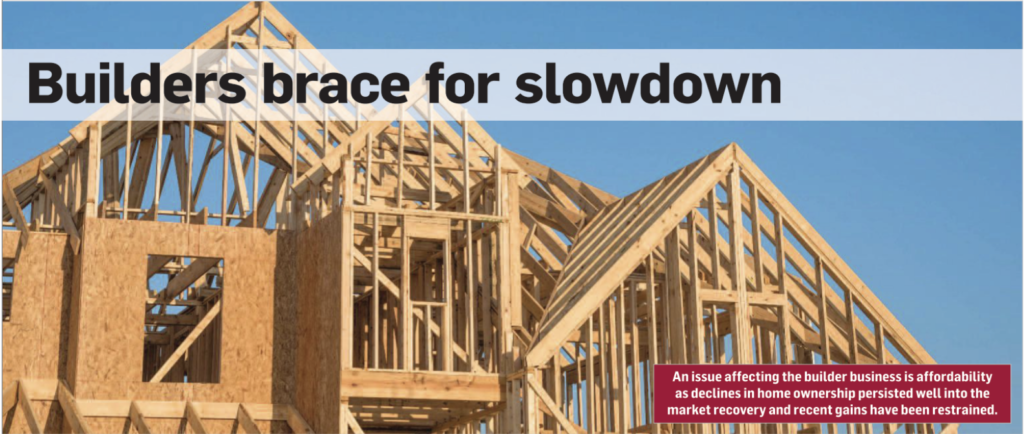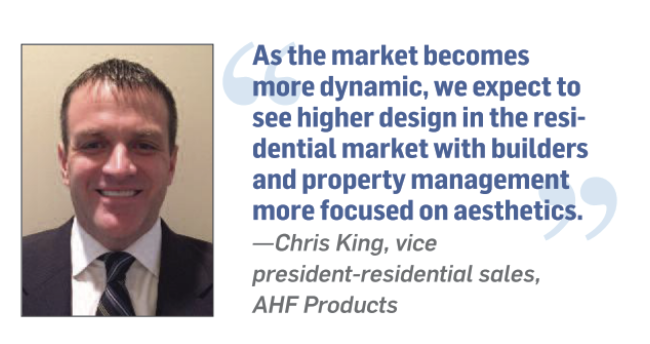January 21/28, 2019: Volume 34, Issue 17
By K.J. Quinn
 For the past eight years, the builder market was a fast-moving catamaran, boasting steady sales growth and playing a major role in the flooring industry’s recovery from the Great Recession. While major sectors of new housing are on track to increase over 2017, higher lending rates, a slowing economy and affordability of single- and multi-family units threaten to take the wind out of its sails in 2019, according to published reports.
For the past eight years, the builder market was a fast-moving catamaran, boasting steady sales growth and playing a major role in the flooring industry’s recovery from the Great Recession. While major sectors of new housing are on track to increase over 2017, higher lending rates, a slowing economy and affordability of single- and multi-family units threaten to take the wind out of its sails in 2019, according to published reports.
Dodge Data & Analytics projects single-family housing starts, the largest piece of the builder business, will slide 3% to 815,000 units in 2019 while multi-family starts drop 8% to 465,000 units. “Total housing starts will decline 5% to 1.28 million units,” Kim Kennedy, manager of forecasting, predicts. “In dollars, single-family housing starts will remain flat in 2019 at $232 billion and multi-family housing starts will fall 6% to $87 billion.”
The sober projections indicate the age of the construction cycle is beginning to show as housing starts climbed 127% from 2009 to 2017. The slowdown began when multi-family starts slipped 4% in 2017 over the prior year, Dodge reported, following seven years where the number of units rose 281%. “Single-family housing starts, by contrast, continued to slide through 2011 before its recovery began,” Kennedy said. “From 2011 to 2017, single-family housing starts climbed a much more reserved 94%.”
Through November 2018, the latest period for which construction data is available, economic conditions remained largely beneficial to single-family housing. Single-family starts were 6% ahead of the same period in 2017, Dodge reported, while multi-family starts were 3% higher in units. In 2018, single-family housing starts are expected to grow 5% to 842,000 units while multi-family starts are projected to increase 2% to 508,000 units.
“This will bring total housing starts to 1.35 million units, 4% higher than last year,” Kennedy said. “In dollars, single-family housing starts are expected to grow 6% this year to $232 billion while multi-family housing starts will increase 5% to $93 billion.”
Privately-owned housing units authorized by building permits in November decreased 0.6% over the revised August rate of 1.249 million and is 1% below the November 2017 rate, according to the most recent construction data from the U.S. Census Bureau and U.S. Department of Housing and Urban Development. Permits for single-family homes rose nearly 3% over August while homes with five units or more declined 9.3%. Housing permits provide a snapshot of how much construction is in the pipeline, as ground is usually broken within 30 to 60 days after a permit is issued.
Construction work issuesNew residential construction data should be taken with a grain of salt as it can be skewed by peaks and valleys in key regions. For example, the South region, the largest in terms of building activity, saw housing starts decline by almost 14%, most likely because of Hurricane Florence, according to published reports. In October, Hurricane Michael was expected to impact starts even further in the South.
“The builders in our market did a better job of selling houses than building them,” said Larry Barr, president and CEO, Floors Inc., Southlake, Texas. “Sales are still holding strong, but build cycles continue to lengthen as labor supplies are strained and weather patterns have us getting significant rain every few weeks.”
A major issue affecting the builder business is affordability as declines in home ownership persisted well into the market recovery and recent gains have been restrained. “Limited gains in income, large increases in house prices and rising mortgage rates are combining to hamper affordability, particularly for first-time homebuyers,” Dodge’s Kennedy reported. “Tight mortgage lending conditions and insufficient numbers of homes for sale are exacerbating the problem.”
The construction industry labor shortage and rising regulatory costs haven’t helped, either. At the close of 2018 there were almost 300,000 unfilled construction jobs, according to the National Association of Home Builders (NAHB). Some regions face a shallower pool of craftsmen than others, which can directly impact speed to market. “This is raising costs and delaying completion times,” said Robert Dietz, NAHB’s senior vice president and chief economist. “Moreover, framing lumber markets saw significant price volatility with pricing up more than 60% at one point during the summer compared to the start of 2017. This led to thousands of dollars in increased construction costs.”
 Meanwhile, rising tariffs stand to impact pricing on building materials and interior decorating products such as flooring. “As the prices of imports continue to rise, we expect to see an increase in domestic sheet vinyl sales,” said Michael Mulligan, director, strategic accounts, multi-family and single-family housing for Tarkett. “Today’s sheet vinyl products are both attractive and affordable, which can present a very attractive alternative to imported LVP.”
Meanwhile, rising tariffs stand to impact pricing on building materials and interior decorating products such as flooring. “As the prices of imports continue to rise, we expect to see an increase in domestic sheet vinyl sales,” said Michael Mulligan, director, strategic accounts, multi-family and single-family housing for Tarkett. “Today’s sheet vinyl products are both attractive and affordable, which can present a very attractive alternative to imported LVP.”
The housing market is important to the flooring industry, representing an estimated one-third of residential sales. Whether dealers target homeowners, designers, trade professionals, builders or property managers, the market can be lucrative for providing the right flooring solutions that match customers’ needs. “As the market becomes more dynamic, we expect to see higher design in the residential market with builders and property management more focused on aesthetics,” said Christopher King, vice president-residential sales, AHF Products.
Homes are becoming smaller, as builders attempt to hit the right price point to sell homes in a specific area, according to industry members. Flooring choices are impacted, in part, by how these spaces are utilized. For example, carpet is projected to remain a go-to product for bedrooms while hard surfaces—led by LVT and WPC products—are growing at a much faster rate in single- and multi-family homes.
“It’s been interesting that where we consider carpet markets in single-family—such as the Northeast and Mid-Atlantic—the trend going on for a few years is where hard surfaces cut into the overall footprint of carpet,” added Scott Baker, vice president national accounts single-family at Shaw Industries. “We’ve seen it in the Midwest and Mid-Atlantic and the overall carpet yardage has declined.”
Led by LVT, hard surfaces continue eating away at the market share of soft surfaces. “LVT will continue to post impressive figures due to its ability to take market share from other resilient products along with other flooring categories overall,” Armstrong’s King said. “In addition, end users are now open to installing LVT in various areas of the home, meaning it is no longer limited to spaces like kitchens, bathrooms and laundry rooms.”
There are changing trends affecting the growth of certain categories in new home construction. For example, natural products, such as hardwood, remain popular for their good looks, longevity, warmth and the potential value they add to the home. “Growth has been in the low single digits on the single-family front and is not a factor on the multi-family front in most markets,” noted Anita Howard, COO, National Wood Flooring Association. “Growth is greater in the higher-end market.”
It’s important for residential flooring contractors to educate new homebuyers about the features and benefits of various floor coverings, experts say, which encourages them to step up and buy. Most upgrades are trending toward kitchens and baths because they offer great return on investment. “Large kitchens and open-concept design are still things that home buyers seem to want,” Armstrong’s King said. “This creates opportunity to sell upgrade flooring as there is no real separation of spaces in these open plans.”
Still, many national builders are reportedly streamlining their product mix and reducing upgrade options to help improve cycle time. “That makes labor more efficient, as they can get into and out of houses quicker,” Shaw’s Baker noted. “They used to sell 50 to 100 different carpets and now it’s 10 or 15. We’re seeing the same thing with hard surfaces.”
Changing needsBuilders are getting bigger, generating more demands on service, price and product. But small, medium, regional and custom home builders maintain an important role in the arena. “Lot development and land availability are bottlenecks for large builders in certain markets and there is a tug-of-war between the trades for labor, generating another impediment in the form of labor inflation,” David Gheesling, CEO, FEI Group, Marietta, Ga., said. “These factors, among others, including an ongoing shift from soft to hard surfaces, make the single-family arena a complicated one to play in at the moment.”
Rising costs and slowing real estate price gains are expected to compress builder profit margins even further in 2019. What this means for suppliers is materials, even with a higher price that offer guaranteed reductions in construction time and costs, will find a ready market among builders seeking to reduce uncertainty associated with skilled labor and subcontractors. “It is also the means by which worker productivity will rise in the residential construction space,” NAHB’s Dietz said. “It would be a wise move by contractors and suppliers to market their products to builders with measurable benefits to labor savings.”
Given the margin pressures and service requirements, the availability of qualified flooring installers remains a major concern, observers say. Builders tend to wait until materials are needed before releasing orders, which, depending on the product category, can cause problems with hitting deadlines. “It’s extremely important for [dealers] to keep their crews and labor consistent,” Shaw’s Baker said. “And their management of that labor at the community or project level is what sets them apart.”
Residential flooring contractors and builders who effectively manage and maintain qualified installation crews can leverage this position as a major competitive advantage.
“Any dealer with excess labor has the opportunity to grow their business,” said Layne Dugger, Shaw’s vice president national accounts multi-family. “Both the single- and multi-family markets continue to be heavily service oriented.”
